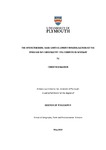THE HYDROTHERMAL RARE EARTH ELEMENT MINERALISATION AT THE PERALKALINE CARBONATITE FEN COMPLEX IN NORWAY
| dc.contributor.supervisor | Dijkstra, Arjan | |
| dc.contributor.author | Marien, Christian | |
| dc.contributor.other | School of Geography, Earth and Environmental Sciences | en_US |
| dc.date.accessioned | 2019-08-14T16:34:03Z | |
| dc.date.available | 2019-08-14T16:34:03Z | |
| dc.date.issued | 2019 | |
| dc.identifier | 10511184 | en_US |
| dc.identifier.uri | http://hdl.handle.net/10026.1/14799 | |
| dc.description | Marien, C., Dijkstra, A.H. and Wilkins, C., 2018. The hydrothermal alteration of carbonatite in the Fen Complex, Norway: mineralogy, geochemistry, and implications for rare-earth element resource formation. Mineralogical Magazine, 82(S1): S115-S131. | en_US |
| dc.description.abstract |
The Fen Complex in Norway consists of a composite carbonatite-ijolite-pyroxenite diatreme intrusion. Locally, the hydrothermally altered, hematite-rich rock rødbergite exhibited high grades (up to 2.1 wt% REE) of rare earth elements (REE). In order to secure the supply of REE for future technology markets in Europe, it becomes increasingly important to establish potential domestic REE sources like the Fen Complex. This project aims to develop a model for the carbonatite-hosted hydrothermal REE deposit (‘Rødbergite’) in the Fen Complex, Norway. SEM and ICP-MS trace element analyses of 73 bulk samples taken along various geological key transects showed the transformation of carbonatite, damtjernite, gneiss and fenite to rødbergite. An alteration mineral assemblage of dolomite, Fe-dolomite, barite, Ba-bearing phlogopite, hematite with accessory apatite, calcite, monazite-(Ce) and quartz replaced the original minerals of the protolith. The transformation to rødbergite is accompanied by an increase in REE concentrations (up to 23-fold) — mainly light REE— and Th. The overall REE concentration of rødbergite varies strongly and depends on the REE concentration of the protolith, density of hydrothermal micro-veins — containing monazite, bastnäsite, synchysite and allanite — and locally apatite relics. While Th-Pb geochronology of zircons established a robust age for the emplacement of the Fen Complex carbonatite with 550 Ma ± 10 Ma, monazite from rødbergite gave U-Pb and Th-Pb ages of 272 Ma ± 5 Ma and 272 Ma ± 10 Ma respectively. The age of the REE-mineralisation coincides with the Oslo rift formation, which is interpreted as the heat source triggering the hydrothermal formation of rødbergite at the Fen Complex The major findings are combined in a new ore deposit model for rødbergite that can help to improve exploration strategies in the Fen complex and has implications for carbonatite-hosted hydrothermal REE resources around the world. | en_US |
| dc.description.sponsorship | NERC Isotope Geosciences Facilities Steering Committee | en_US |
| dc.language.iso | en | |
| dc.publisher | University of Plymouth | |
| dc.subject | Carbonatite | en_US |
| dc.subject | Hydrothermal Alteration | en_US |
| dc.subject | Rare Earth Elements | en_US |
| dc.subject | REE | en_US |
| dc.subject | Fen Complex | en_US |
| dc.subject | Mineralisation | en_US |
| dc.subject | Rødbergite | en_US |
| dc.subject.classification | PhD | en_US |
| dc.title | THE HYDROTHERMAL RARE EARTH ELEMENT MINERALISATION AT THE PERALKALINE CARBONATITE FEN COMPLEX IN NORWAY | en_US |
| dc.type | Thesis | |
| plymouth.version | publishable | en_US |
| dc.identifier.doi | http://dx.doi.org/10.24382/604 | |
| dc.rights.embargoperiod | No embargo | en_US |
| dc.type.qualification | Doctorate | en_US |
| rioxxterms.version | NA | |
| plymouth.orcid_id | https://orcid.org/0000-0002-3217-3956 | en_US |
Files in this item
This item appears in the following Collection(s)
-
01 Research Theses Main Collection
Research Theses Main


